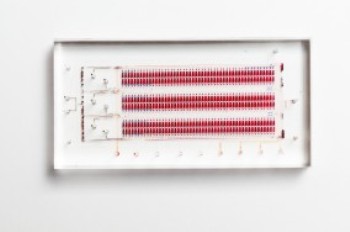Researchers at University of British Columbia (UBC) have developed a silicone lab-on-a-chip to enhance genetic analysis and render it to be more rapid, cost-effective, and sensitive by enabling single cells to fit into their respective places similar to balls falling into place in a pinball machine.
 Microfluidic chip
Microfluidic chip
The UBC device is the same as the size of a 9 V battery. It allows researchers to analyze 300 individual cells simultaneously by directing cells carrying fluid along microscopic valves and tubes. After isolation is done in their respective chambers, the RNA of the cells are separated and duplicated for additional analysis. Such type of single-cell analysis enables the device to enhance genetic research and allow for more comprehensive tests in diagnosing tumor.
Single-cell analysis is evolving as a standard step in genetic research as tissue samples though collected from a single tumor may contain a combination of both cancer cells and the normal cells. The biggest problem is that cells which are considered to be important may be available in minute quantities and also it may be difficult to identify them. Hence, a standard genetic test which normally requires numerous cells to be analyzed portrays only an overall average picture concealing the true characteristics of cells and their interactions.
The UBC device integrates all features needed to perform a cell analysis such as isolating the cells, combining the cells with chemical substances to differentiate its genetic code, and finally evaluating the test results by determining the emitted fluorescent light from the reaction. Since all these are addressed by a single chip, the UBC device is cost-saving and easy to work with.
This device was invented by UBC research team headed by Carl Hansen, an assistant professor in the Department of Physics and Astronomy and the Centre for High-Throughput Biology, collaborating with the Centre for Translational and Applied Genomics and BC Cancer Agency.